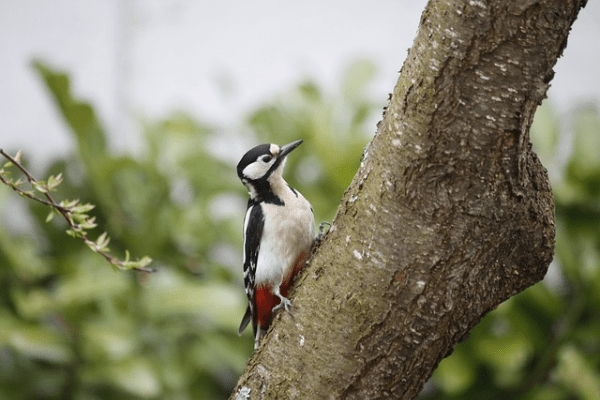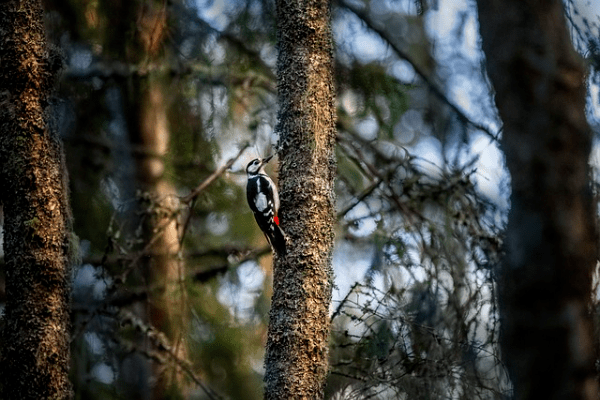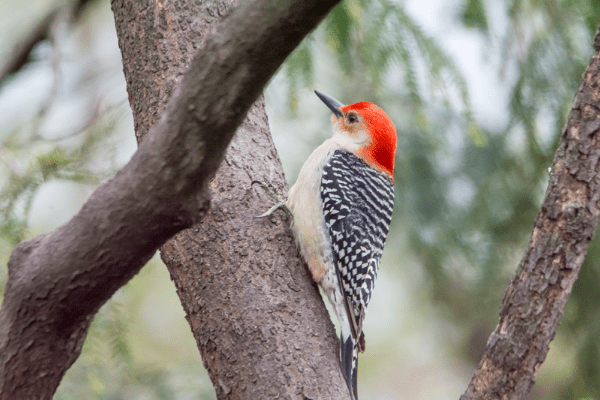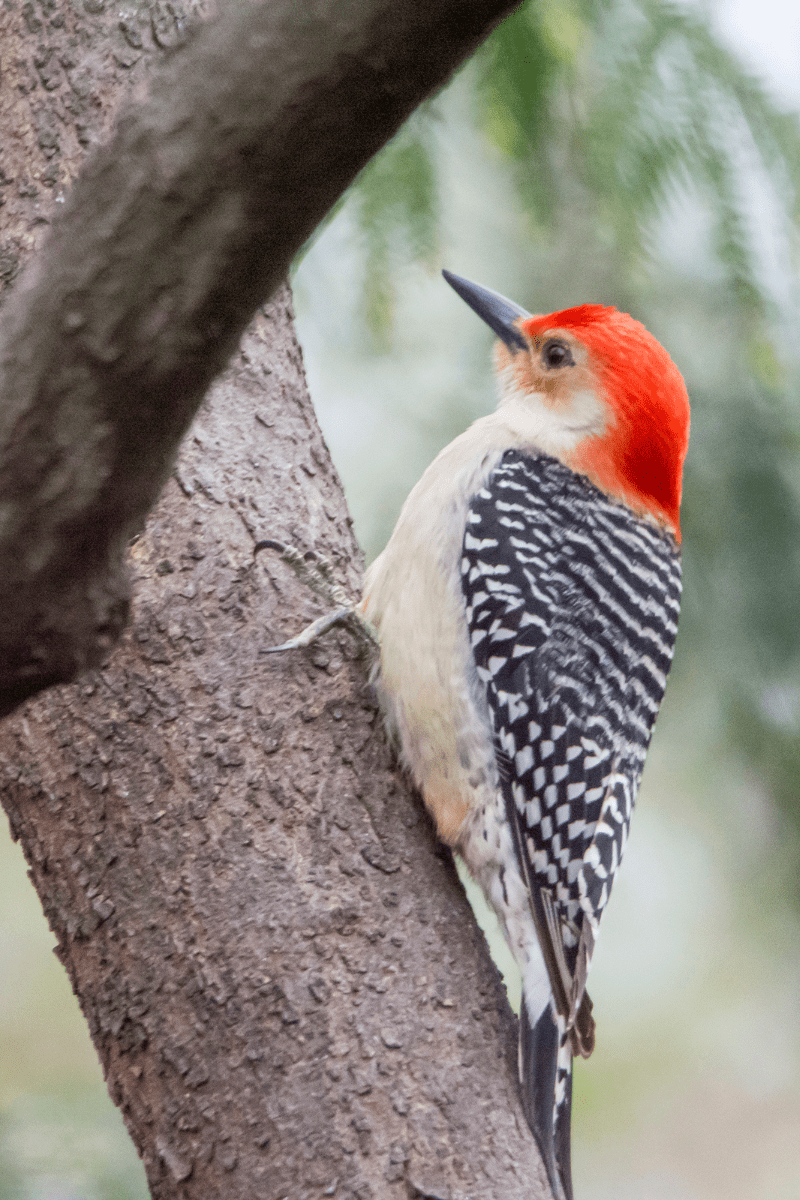Contents
Have you ever wondered how woodpeckers can hammer away at wood or metal without getting a concussion? In fact, they can sit there banging away at these things all day without even walking away with a headache. Find out the reasons why and much more below.
The woodpecker skull has adapted to handle their pecking and banging. The front of their skulls has adopted a spongy bone to absorb shocks from pecking while keeping their soft brain protected. Scientists also learned from micro-CT scans that woodpeckers have thick neck muscles and resilient bones to protect them from brain injury.
Below, going to cover this topic in much greater detail. I will look at the main question and other related issues to help you better understand how woodpeckers are capable of avoiding concussions. The main issues that I’ll cover today include:
- Why Woodpeckers Do Not Get Concussions
- Woodpecker Anatomy
- The Shock-Absorber Hypothesis
- Do Woodpeckers Ever Get Hurt?
I’ll answer these questions and more in greater detail below. Continue reading to discover the truth about woodpeckers and their ability to avoid headaches and concussions.

Woodpecker Head and Neck 101
A scientist by the name of Sam Van Wassenbergh wanted to test the hypothesis claiming that woodpeckers have shock absorbers in their head and neck area. While he found this hypothesis intriguing, he didn’t think it was a viable explanation in reality.
To find out more, and to discover whether or not his suspicions were correct, he used high-speed video to record three species of woodpeckers with his colleagues from the University of Antwerp. While filming these birds, the videos revealed images captured with a high-speed camera that operates at 4000 frames per second. They filmed the woodpeckers hammering directly into the wood, which gave them the ability to analyze the frames to track head movement and more.
According to information shared in The Atlantic by Van Wassenbergh, “If the skull was really absorbing shocks, then upon each pack, the brain should decelerate far less than the beak – just as when a car hits a bump, its body jerks less than its wheels do.”
So, what did the high-speed images discover?
After seriously analyzing each one of these image frames, they took a look at how the woodpeckers’ heads in relation to one another. They learned: the entire woodpecker plus the brain come to a complete stop at the same time.
What actually happens when woodpeckers peck at wood or other surfaces?
- The woodpecker’s brain is orientated in a way that it increases the contact area while pecking, which reduces stress on the woodpecker’s brain.
- The small size of this bird is also a factor because it gives the woodpecker the ability to accelerate the movement of its head at high speeds.
- The hyoid, which is a springy structure at the back of the woodpecker’s skull, keep cerebrospinal fluid suppressed to keep vibrations at a minimum.
- The apparatus of the woodpecker’s jaw helps to cushion the packing process.
Overall, the sophisticated woodpecker anatomy ultimately prevents this bird from suffering from concussions, headaches, or other potentially devastating maladies due to its incessant woodpecker pecking and banging.
Related article: Pileated woodpecker

Woodpecker Anatomy: How the Head and Brain Are Designed For Protection
According to Let’s Talk Science, “Pecking puts a lot of force on a woodpecker’s brain. In fact, this force is around 10 times greater than what would cause a concussion in humans. But for a long time, scientists have thought that woodpeckers don’t get headaches or concussions.”
As the woodpecker strikes a tree, the striking movement creates a massive force on the beak of the woodpecker. But their overall anatomy is designed to absorb the force of the blow, which stops the woodpecker from ever becoming injured while making a pecking motion. In fact, woodpeckers peck so often that they do it as many as 12,000 times per day.
It has a specialized skull and beak. These specialized parts of their anatomy help to direct the brunt of the energy associated with the pecking motion and spread it throughout their body. This keeps their brain protected and prevents injury and concussions.
The Woodpecker’s Head
Scientists have learned that there are a few features of woodpecker anatomy that keep them protected. For starters, woodpeckers are made up of a bony tongue-supporting structure that begins within their mouth and wraps all the way around the entire woodpecker’s skull. This spongy tongue-supporting structure attaches between their eyes.
The name of the structure is called the hyoid. What is its major function to help protect woodpeckers from getting concussions and traumatic brain injuries?
- Scientists have deemed the hyoid as a seatbelt that covers the woodpecker’s brain for added protection
- The hyoid effectively minimizes the energy caused by the woodpeckers become colliding into wood or metal surfaces by absorbing part of the dispersed energy
This anatomical feature is incredibly important to the health and well-being of all woodpeckers. Without it, they would likely experience massive headaches and concussions every time they pecked their beak into a wooden or metal surface at high speeds and velocity.
Did you ever think you’d need to protect your home from woodpeckers?
When a woodpecker is hammering on your house, it can be loud and obnoxious! Click the button below to learn how to get woodpeckers to leave your house alone.
The Woodpecker’s Brain
According to an article shared on Forbes.com, “There are several physiological differences that protect the woodpecker’s brain from trauma that do not exist in humans, or function very differently than they do in humans.”
The main differences include:
- The brain of the woodpecker is packed into the skull very wholly and tightly fills the space, which is different from the human brain because it can move around within the skull. This difference is responsible for preventing brain damage and chronic traumatic encephalopathy.
- The size of the woodpecker brain also plays a role in the ability to avoid concussions, unlike human beings. Woodpecker brains are incredibly small, which means their surface area to weight ratio is distributed throughout the entire region of their brain, which helps mitigate the impact of the force. This doesn’t happen with human brains, unfortunately, because humans can experience blunt trauma in specific areas of the brain.
- The hyoid bone is a cushion or seat belt to protect the woodpecker’s brain from impact. Human beings do not have a hyoid bone to provide this additional protection.
Related article: Woodpeckers – Birdwatching, Facts, Woodpecker Birds
The Shock Absorber Hypothesis
Sam Van Wassenbergh admits that the idea of shock absorption in woodpecker heads/brain areas makes a lot of sense and seems like a sound hypothesis. But in truth, he believes that it makes a lot less sense the more you actually think about it.
Why do woodpeckers peck at trees?
- To send messages
- To find hidden insects
- To excavate holes for nesting
According to Van Wassenbergh, “… Many of their body parts – strong beaks, grasping feet, and stiff, strut-like tails – have evolved to maximize the kinetic energy they deliver with each blow. If their skulls absorbed that energy, they’d need to pound harder, which would negate any benefits from the absorption. If what you need is a hammer, why strap a cushion onto its head?”
The scientist comes to a very valid conclusion with his line of thinking. If the skull was actually absorbing all of this massive amount of energy, why would it be designed to cushion the blow? It would just make the woodpecker have to work much harder by pounding its woodpecker head even faster into the wood. This would make a lot less sense because it would make it harder for the birds to communicate, excavate nesting holes, and dig for delectable insects. And it could even lead to head injuries.
Do Woodpeckers Ever Get Hurt?
Is it true that woodpeckers never get hurt? No, this is a myth, unfortunately. They may not hurt their head or get concussions during the packing process, but they can certainly get hurt by getting hit or experiencing another type of impact in a vulnerable situation.
As an example, some woodpeckers tend to get injured or even killed flying into windows. They will fly headfirst into a window and accidentally kill themselves. So, their ability to never get hurt doesn’t actually exist.
Yet, recent research leads us to believe that woodpeckers do not suffer brain damage, but the theory isn’t completely proven at this point.
In 2018, there was a study that was published on woodpeckers. The study taught us that the brains of woodpeckers contain tau, a protein. In human beings, this protein is directly associated with brain damage.
At the time of this writing, scientists aren’t fully aware of how this protein works in woodpeckers or human brains. But the discovery of this protein and woodpecker brains reminds us that science is ever evolving and there are always new questions to consider.


